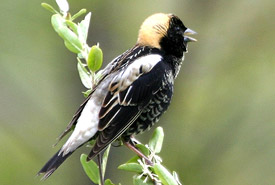
Bobolink (Photo by Bill Hubick)
Bobolink
An unmistakable bird on the grasslands, the male bobolink’s plumage resembles a tuxedo worn backwards. The male’s call is a bubbly, tinkling song with sharp notes sung from perches and during aerial displays.
These medium-sized songbirds have one of the world’s longest migrations, travelling over 20,000 kilometres between their wintering grounds in southern South America and their breeding grounds in southern Canada and northern U.S. each year. To navigate this long-distance journey, bobolinks rely on their built-in compass — bristles in the tissues of their nasal cavity that contain iron oxide — to orient them to the Earth’s magnetic fields.
What does the bobolink look like?
Breeding male bobolinks have a black front with a white back and rump, and a yellowish nape. Females and non-breeding birds are light beige, with streaks of dark brown on the back and flanks. Their conical-shaped bill is designed to extract seeds and forage for small grains and insects.
Bobolinks moult their feathers twice a year. By end of summer, male bobolinks undergo a complete makeover, moulting to resemble females or juvenile birds. On their wintering grounds, males moult once again to eventually grow back the striking black, white and yellow breeding plumage.
Where does the bobolink live?
Across southern Canada, bobolinks breed in prairies, meadows, hayfields and other grassland habitats.
Following the breeding season, bobolinks move to freshwater marshes and coastal regions in the southern U.S. to moult before taking flight to migrate to their wintering grounds, where they take up their lives in grasslands, marshes, rice fields and sorghum fields.
What is the bobolink's conservation status?
Bobolinks are assessed as special concern in Canada by the Committee of the Status of Endangered Wildlife in Canada and listed under the Species at Risk Act.
Bobolink populations are declining because of the loss of prairies and other grasslands habitats. Their use of hay fields for nesting can make them vulnerable to accidental mortality during harvest before the end of the nesting season (generally before July 15). Habitat loss and fragmentation is the key threat for this species. Climate change could also exacerbate their vulnerability related to earlier haying of crops in the summer if growing seasons are extended with warmer temperatures. Pesticide use on their wintering and breeding grounds may also be contributing to their decline.
What is NCC doing to protect the bobolink's habitat?
The Nature Conservancy of Canada (NCC) actively conserves habitats for grassland birds, including the bobolink, which require prairies, savannah and other grassland habitats to survive.
In Ontario, this species can be spotted in the Rice Lake Plains and MacMillan Nature Reserve, where we are restoring native grassland and savannah habitat. In Manitoba, it can be seen on NCC’s Jiggens Bluff, Tall Grass Prairie Preserve and Fort Ellice properties. In Saskatchewan, the bobolink is found on NCC properties in the Missouri Coteau, Upper Qu’Appelle, Saskatoon Prairie, Milk River Basin, Cypress Upland, and Lower Qu’Appelle-Assiniboine-Quill Lakes Natural Areas. In Alberta, the bobolink has been spotted in the Edmonton area in the north and the Waterton area in the south. On NCC properties with agricultural lands, haying is delayed until after July 15 to allow the birds the opportunity to finish nesting. In British Columbia, this charming bird inspired the naming of NCC’s Bobolink Meadows Conservation Area, which protects some of the most significant bobolink breeding habitat in the Okanagan Valley.
This species has been observed on a number of properties along the St. Lawrence River in Quebec. This includes Île de Grâce and Île du Moine in the Lac Saint-Pierre archipelago and Île aux Grues in the estuary. In the Ottawa Valley, bobolinks have also been observed in the Ruisseau-Breckenridge Nature Reserve.





